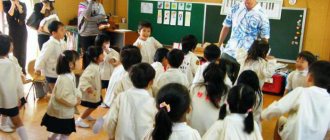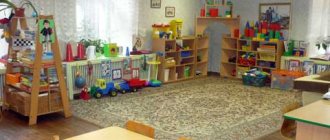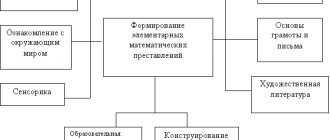Project activities in preschool educational institutions: approaches, content
Currently, in preschool education, traditional education is being replaced by developmental education, which is aimed at developing creative abilities , developing cognitive interest and the need for active creative activity in preschoolers. The project method fully complies with the requirements of the Federal State Educational Standard for preschool education and can be implemented both within the framework of the cognitive development of preschool children and through the integration of educational areas .
The project method as a set of educational and cognitive techniques that make it possible to solve a particular problem as a result of independent actions of students with the obligatory presentation of these results.
The goal is to develop the creative abilities of the child’s personality, which are determined by the developmental tasks and tasks of the children’s research activities.
Objectives : - teach basic planning; — develop skills in collecting and processing information and materials; — develop creative abilities; - to form a positive attitude towards cognitive, research, creative activities.
Basic requirements for project activities: - the presence of a problem that requires integrated knowledge and a research search for its solution; — practical, theoretical, cognitive significance of the expected results; - independent activity of a preschooler; - use of research methods, i.e. defining the problem, the research tasks arising from it, putting forward a hypothesis for their solution. Discussion of research methods, presentation of final results, analysis of the data obtained, summing up, adjustments, conclusions.
Typology of projects : (according to E. S. Evdokimova “Design technology in preschool educational institutions”) - the dominant activity in the project: research, search, creative, role-playing, applied (practice-oriented), orientation, etc. (research project, game, practice-oriented, creative); — subject-content area : mono project (within one area of knowledge), interdisciplinary project; — the nature of project coordination (leadership from the teacher): direct (rigid, flexible), hidden (implicit, simulating a project participant, typical for telecommunications projects); — number of project participants (individual, pair, group); — duration of the project (short-term (1-2 lessons), medium-term (up to a month), long-term.
A feature of project activities in the preschool education system is that the child cannot yet independently find contradictions in the environment, formulate a problem, or determine a goal (intention). Therefore, in the educational process of a preschool educational institution, project activities are in the nature of cooperation, in which children and teachers of the preschool educational institution take part, and parents and other family members are also involved. Parents can not only be sources of information, real help and support for the child and teacher in the process of working on the project, but also become direct participants in the educational process. In this way, parents can enrich their teaching experience, experience a sense of ownership and satisfaction from their successes and the successes of their child [1]
The specificity of using the project method in preschool practice is that adults need to “guide” the child, help detect a problem or even provoke its occurrence, arouse interest in it and “draw” children into a joint project, without overdoing it with parental care and help. Project activities in kindergarten can be represented as a way of organizing the pedagogical process, based on the interaction between teacher and student, a way of interaction with the environment, step-by-step practical activities to achieve the goal [1].
In a preschool institution there may be [2]: 1. Information projects - aimed at collecting information about some object, familiarizing project participants with this information, analyzing it and summarizing facts intended for a wide audience; — structure of the information project: receiving and processing information, obtaining results, presentation.
An example of an information project can be viewed here.
2. Research projects - a research search is carried out, the results of which are presented in the form of some kind of creative product (newspapers, dramatizations, card indexes of experiences, children's design, cookbook, etc.)
An example of a research project can be viewed here.
3. Role-playing projects are projects with elements of creative games, when children take on the role of fairy tale characters and solve the problems in their own way. 4. Creative projects - as a rule, do not have a detailed structure of joint activities of participants; — creative projects are classified according to the dominant type of creativity: artistic and visual, artistic and speech, artistic and design, theatrical, musical, etc.)
An example of a creative project can be viewed here.
Activities of the teacher : At stage 1 - determines the topic, carries out planning, organizes a subject-development environment, informs parents, studies literature. In the process of joint activities with students, he formulates a problem, helps set a goal, and offers to immediately determine the product of the project; immerses you in a game (plot) problem situation. At stage 2 - helps to divide into groups; helps in solving problems; helps plan activities (where to start). Organizes search and research activities of children. At stage 3 - provides practical assistance to children, creates conditions and motivates children. Monitors and coordinates the project. Records the results of information searches, etc. At stage 4 - preparation for the presentation. Presentation (project defense), evaluation.
Activities of preschoolers : At stage 1 - entering into the problem, “getting used to” the game situation, accepting the task, suggestions and additions to the final product. At stage 2 , children are organized into working groups, assigned directions for collecting material and areas of responsibility. At stage 3 - accumulation, systematization and assimilation of new knowledge, skills, abilities. At stage 4 - preparation for project defense, production of the final product. Presenting the products of your activities to the audience
Structure of the educational project: - name of the project; — authors, coordinators, administrators, project organizers; — general characteristics of the project: project participants, project deadlines, project goals and objectives, project hypothesis, expected results; — stages of the project; — project results, their evaluation, prizes and awards.
Sample topics:
- complex:
“World of Theater”, “Hello, Pushkin!”, “Echo of Centuries”, “Book Week”; - intergroup:
“Mathematical collages”, “The world of animals and birds”, “Seasons”; - creative:
“My friends”, “In our boring garden”, “We love fairy tales”, “The world of nature”, “Rowan berries of Russia”; - group:
“Tales of Love”, “Know Yourself”, “Underwater World”, “Fun Astronomy”; - individual:
“Me and my family”, “Family tree”, “Secrets of grandma’s chest”, “Fairytale bird”; - research:
“The World of Water”, “Breath and Health”, “Nutrition and Health”.
In terms of duration, they can be short-term (one or several lessons), medium-long, long-term (for example, “Pushkin’s Work” - for the academic year).
Approximate scheme for the implementation of the “Family” project (old age)
Sources:
- Kovylyaeva L. A., Tretyakova N. I. Using technology of project activities in teaching preschoolers // Scientific and methodological electronic journal “Concept”. – 2016. – T. 46. – P. 167–175. – URL: https://e-koncept.ru/2016/76508.htm.
- Project activities in preschool educational institutions
- https://doshvozrast.ru/metodich/konsultac04.htm
Colleagues!
Let's think about it...
What place does project activity occupy in preschool education?
Features of a teacher’s use of the project method in a preschool educational institution
Author: Sherstobitova Irina Vladimirovna, teacher of category I, MBDOU No. 113, Arkhangelsk
Abstract: The article shows the role of the project method in the education and development of a modern preschooler, identifies the features of using this method in the work of a preschool teacher, and reveals the essence of the concept of a project.
Features of a teacher’s use of the project method in a preschool educational institution
In the context of modernization of domestic education, Russian preschool educational institutions (hereinafter referred to as preschool educational institutions) are restructuring their work in accordance with new regulatory documents: Strategy for Innovative Development of Russia for the period until 2022; Priority national project “Education”; National educational initiative “Our New School”, Federal Law “On Education”, Federal state requirements for the structure of the basic general education program of preschool education and others. The formation of a new education system focuses on the global space and requires significant changes in the pedagogical theory and practice of preschool educational institutions, as well as pedagogical technologies. Consequently, the pedagogical process in preschool educational institutions should be organized through the selection of the most effective means of teaching and education, which, in turn, requires the widespread introduction of innovative forms and methods into educational activities that are carried out within the walls of the kindergarten.
Today, traditional education is being replaced by productive learning, the main goal of which is the development of creative, communicative and organizational abilities, the formation in preschoolers of interest and the need for active creative activity. That is why one of the methods that helps solve this issue is the design method.
The word “project” comes from the Latin word projects, which means thrown forward, protruding, protruding forward, and translated from Greek this word means the path of research. And so, a project is a plan, an idea, an image, embodied in the form of a description, justification of calculations that reveal the essence of the plan and the possibility of its practical implementation [1].
The project method in the activities of preschool institutions is discussed in detail in the scientific works of T.A. Danilina, L.S. Kiseleva, T.S. Ladoga, where this method is understood as a variant of the integrated method of teaching preschoolers, as a way of organizing the pedagogical process, based on the interaction of teacher and student, step-by-step practical activities to achieve the goal [2].
Today, this term is associated with the concept of “problem”, in connection with this, the project method is understood as a set of educational and cognitive techniques with the help of which one or another problem can be solved as a result of independent actions of students, in this case preschoolers, with the obligatory presentation of these results .
Thus, the essence of the project method is to stimulate children’s interest in certain problems, the solution of which requires knowledge, and through project activities to show the application of this knowledge in practice. This allows us to consider this method as an innovation in preschool education; the activities between the teacher and preschoolers will be in the nature of cooperation, where other subjects of the educational process, for example, parents, can take part. Consequently, the project method makes the educational system of preschool educational institutions open to the active participation of children and their parents, and its main goal is the development of a free creative personality, which is determined by the development tasks and tasks of children’s research activities, where adults are assistants and guide this activity [].
The process of using the project method in preschool educational institutions has its own specifics, for example, an adult needs to guide the child, help detect a problem, provoke its occurrence, arouse interest in it and involve children in a joint project, while the participation of parents here is minimal, guardianship and assistance should be in moderation . The teacher acts as an organizer of children's productive activities, he is a source of information, a consultant, an expert. He must remember the main principle in working with preschoolers, this is taking into account their age characteristics, creating a variety of conditions to stimulate their interest and create motivation for children’s activities. As a result of such work, the child’s independent, proactive, active personality develops.
The above suggests that the project method with preschoolers today is an innovative and promising method that should take its rightful place in the preschool education system.
Bibliography:
1. B. Raizberg, L. Lozovsky, E. Starodubtseva / Modern economic dictionary.
2. Project method in the activities of a preschool institution: a manual for managers and practical workers of preschool educational institutions / Authors - compilers: L.S. Kiseleva, T.A. Danilina, T.S. Ladoga, M.B. Zuykova – 3rd edition. M.: ARKTI, 2005.
We recommend watching:
Educational – creative project in the preparatory group “Soon to school”
Pedagogical project in the second junior group of kindergarten
Pedagogical project in the middle group “Know and follow the road rules!”
Creative project in the traffic rules preparatory group: “Signs warning pedestrians and drivers of danger”
Project in the middle group “City for little pedestrians”






